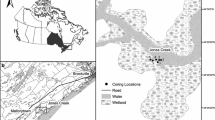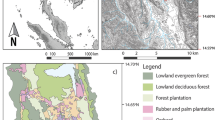Abstract
Increased human activities since discovery of gold in northern California have changed the structure and function of many ecosystems. To reconstruct the changes in watershed environmental conditions, sediment cores were collected from three montane marshes in northern Sierra Nevada, CA. Pollen analysis was conducted, and water content, bulk density, ash, carbon, nitrogen, phosphorus, major cations, and lead concentrations of sediments were determined. Cores were dated by the 210Pb method. Pollen analyses showed changes in plant communities in this region due to severe logging in the late-1800s and moderate logging in the 1900s. The local changes were more clearly recorded in small marsh pollen profiles than regional changes. The water milfoil (Myriophyllum spicatum L.) introduction into Tahoe Basin was inferred from the pollen record and 210Pb dating. Road construction and maintenance activities were recorded in physical and chemical characteristics, such as increases in sodium, calcium, and magnesium concentrations. Pollen and physical and chemical records also documented the time line of the expansion of dry meadow, and the decrease of pine forest in one of the watersheds. This study showed that sediments in small marshes were especially useful to reconstruct local disturbance by human activities.
Similar content being viewed by others
References
Alcala-Herrera, J. A., J. S. Jacob, M. L. M. Castillo & R. W. Neck, 1994. Holocene paleosalinity in a Maya wetland, Belize, inferred from the microfaunal assemblage. Quat. Res. 41: 121–130.
Aiken, S. G., 1978. Pollen morphology in the genus Myriophyllum (Haloragaceae). Can. J. Bot. 56: 976–982.
Allen, S. A., 1989. Chemical analysis of ecological materials. 2nd edn. Blackwell, Oxford, 368 pp.
Appleby, P. G. & F. Oldfield, 1986. The calculation of lead-210 dates assuming a constant rate of supply of unsupported 210Pb to the sediment. Catena 5: 1–8.
Bartow, S. M., C. B. Craft & C. J. Richardson, 1996. Reconstructing historical changes in Everglades plant community composition using pollen distributions in peat. Lake Res. Mgmt 12: 313–322.
Behre, K.-E., 1981. The interpretation of anthropogenic indicators in pollen diagrams. Pollen et Spores 23: 225–245.
Belyea, L. R. & B. G. Warner, 1996. Temporal scale and the accumulation of peat in a Sphagnum bog. Can. J. Bot. 74: 366–377.
Billen, G. & J. Garnier, 1997. The Phison River plume: coastal eutropication in response to changes in land use and water management in the watershed. Aquat. Microb. Ecol. 13: 3–17.
Binford, M. W., 1990, Calculation and uncertainty analysis of 210Pb dates for PIRLA project lake sediment cores. J. Paleolim. 3: 253–267.
Binford, M. W., J. S. Kahl & S. A. Norton, 1993. Interpretation of 210Pb profiles and verification of the CRS dating model in PIRLA project lake sediment cores. J. Paleolim. 9: 275–296.
Birks, H. J. B. & H. H. Birks, 1980. Quaternary palaeoecology. Edward Arnold. London, 289 pp.
Blais, J. M., J. Kalff, R. J. Coynett & R. D. Evans, 1995. Evaluation of 210Pb dating in lake sediments using stable Pb, Ambrosia pollen, and 137Cs. J. Paleolim. 13: 169–178.
Boynton, W. R., J. H. Garber, R. Summers & W. M. Kemp, 1995. Inputs, transformations, and transport of nitrogen and phosphorus in Chesapeake Bay and selected Tributaries. Estuaries 18: 285–314.
Bradbury, J. P. & P. C. Van Metre, 1997. A land-use and waterquality history of White Rock Lake reservoir, Dallas, Texas, based on paleolimnological analysis. J. Paleolim. 17: 227–237.
Brenner, M., T. J. Whitemore & C. L. Schelske, 1996. Paleolimnological evaluation of historical trophic state conditions in hypereutrophic Lake Thonotosassa, Florida, USA. Hydrobiologia 331: 143–152.
Bunting, M. J., H. C. Duthie, D. R. Campbell, B. G. Warner & L. J. Turner, 1997. A paleoecological record of recent environmental change at Big Creek Marsh, Long Point, Lake Erie. J. Great Lakes Res. 23: 349–368.
Burke. M. T., 1987. Grass lake, El Dorado County. Lake Tahoe Basin Management Unit, US Forest Service, 87 pp.
Carpenter, S. R., N. F. Caraco, D. L. Correll, R. W. Howarth, A. N. Sharpley & V. H. Smith, 1998. Nonpoint pollution of surface waters with phosphorus and nitrogen. Ecol. Appl. 8: 539–568.
Craft, C. B. & C. J. Richardson, 1998. Recent and long-term organic soil accretion and nutrient accumulation in the Everglades. Soil Sci. Soc. Am. J. 62: 834–843.
Dean, W. E., Jr., 1974. Determination of carbonates and organic matter in calcareous sediment and sedimentary rocks by loss on ignition: Comparison with other methods. J. Sed. Petrol. 44: 242–248.
Dorland, D., 1980. Two post-glacial pollen records from Meyers Grade Marsh and Grass Lake, El Dorado Co., California. MA thesis. San Francisco State University, 103 pp.
Faegri, K. & J. Iverson, 1989. Textbook of Pollen Analysis. John Wiley and Sons. New York, 328 pp.
Goldman, C. R., 1989. Lake Tahoe: Preserving a fragile ecosystem. Environment 31: 6–30.
Gorham, E., 1991. Northern peatlands: Role in the carbon cycle and probable responses to climatic warming. Ecol. Appl. 1: 182–195.
Green, C. T., 1998. Integrated studies of hydrogeology and ecology of Pope Marsh, Lake Tahoe. Thesis, University of California, Davis.
Haflidason, H., G. Larsen & G. Olafsson, 1992. The recent sedimentation history of Thingvallavatn, Iceland. OIKOS 64: 80–95.
Hassan, K. M., J. B. Swinehart & R. F. Spalding, 1997. Evidence for Holocene environmental change from C/N ratios, and d13C and d15N values in Swan Lake sediments, western Sand Hills, Nebraska. J. Paleolim. 18: 121–130.
Hemond, H. F., 1980. Biogeochemistry of Thoreau's Bog, Concord, Massachusetts. Ecol. Monogr. 50: 507–526.
Hemond, H. F., 1983. The nitrogen budget of Thoreau's Bog. Ecology 64: 99–109.
Heyvaert, A. C., 1998. The biogeochemistry and paleolimnology of sediments from Lake Tahoe, California-Nevada. Dissertation, University of California, Davis, 194 pp.
Ingram, W. & P. Sabatier, 1987. A Descriptive History of Land Use and Water Quality Planning in the Lake Tahoe Basin. The Institute of Government Affairs and The Institute of Ecology. Institute of Ecology Report #31, 75 pp.
Jacobson, H. A. & D. R. Engstrom, 1989. Resolving the chronology of recent lake sediments: an example from Devils Lake, North Dakota. J. Paleolim. 2: 81–97.
Janssen, C. R., 1966. Recent pollen spectra from the deciduous and coniferous-deciduous forests of northeastern Minnesota: a study in pollen dispersal. Ecology 47: 804–825.
Jassby, A. D., 1998. Interannual variability at three inland water sites: implications for sentinel ecosystems. Ecol. Appl. 8: 277–287.
Khan, H. & G. S. Brush, 1994. Nutrient and metal accumulation in a freshwater tidal marsh. Estuaries 17: 345–360.
Leavitt, P. R., S. R. Carpenter & J. F. Kitchell, 1989. Wholelake experiments: the annual record of fossil pigments and zooplankton. Limnol. Oceanogr. 34: 700–717.
MacKenzie, A. B., E. M. Logan, G. T. Cook & I. D. Pulford, 1998. A historical record of atmospheric depositional fluxes of contaminants in west-central Scotland derived from an ombrotrophic peat core. Sci. Total Environ. 222: 157–166.
Mathewes, R. W., 1978. Pollen morphology of some western Canadian Myriophyllum species in relation to taxonomy. Can. J. Bot. 56: 1372–1380.
Middleburg, J. J., J. Nieuwenhuize, F. J. Slim & B. Ohowa, 1996. Sediment biogeochemistry in an East African mangrove forest (Gazi Bay, Kenya). Biogeochemistry 34: 133–155.
Miller, R. L. Jr., D. R. Dewalle, R. P. Brooks & J. C. Finley, 1997. Long-term impacts of forest road crossings of wetlands in Pennsylvania. Northern J. Appl. Forest. 14: 109–116.
Moor, P. D., 1993. The origin of blanket mire, revisited. In Chambers F. M. (ed), Climate Change and Human Impact on the Landscape. Chapman & Hall, London, pp. 217–224.
Murray, T. E. & J. F. Gottgens, 1997. Historical changes in phosphorus accumulation in a small lake. Hydrobiologia 345: 39–44.
Olsson, S., J. Regnell, A. Person & P. Sandgren, 1997. Sedimentchemistry response to land-use change and pollutant loading in a hypertrophic lake, southern Sweden. J. Paleolim. 17: 275–294.
Poach, M. E. & S. P. Faulkner, 1998. Soil phosphorus characteristics of created and natural wetlands in the Atchafalaya Delta, LA. Estuarine, Coastal and Shelf Science 46: 195–203.
Prentice, I. C., 1985. Pollen representation, source area, and basin size: toward a unified theory of pollen analysis. Quat. Res. 23: 76–86.
Reddy, K. R., R. D. DeLaune, W. F. DeBusk & M. S. Koch, 1993. Long-term nutrient accumulation rates in the Everglades. Soil Sci. Soc. Am. J. 57: 1147–1155.
Rejmankova, E., M. Rejmanek, T. Tjohan & C. R. Goldman, 1999. Resistance and resilience of subalpine wetlands with respect to prolonged drought. Folia Geobotanica 34: 175–188.
Robbins, J. A., 1978. Geochemical and geophysical applications of radioactive lead. In Nriagu J. O. (ed), Biogeochemistry of Lead in the Environment. Elsevier, Holland, pp. 285–393.
Sah, R. N. & R. O. Miller, 1992. Spontaneous reaction for acid dissolution of biological tissues in closed vessels. Analyt. Chem. 64: 230–233.
Schlesinger, W. H., 1997. Biogeochemistry. An Analysis of Global Change, 2nd edn. Academic Press. San Diego, 588 pp.
Smith, J. D. & T. F. Hamilton, 1984. Improved technique for recovery and measurement of polonium-210 from environmental materials. Analyt. Chim. Acta 160: 69–77.
Smith, R. A., 1969. Reconnaissance Report, Lake Tahoe Basin Area. A.I.P., Planning Consultant Reno-Lake Tahoe, 26 pp.
Smol, J. P., S. R. Brown & R. N. McNeely, 1983. Cultural disturbances and trophic history of a small meromictic lake from central Canada. Hydrobiologia 103: 125–130.
Stager, J. C., P. R. Leavitt & S. S. Dixit, 1997. Assessing impacts of past human activity on the water quality of upper Saranac Lake, New York. Lake Res. Mgmt. 13: 175–184.
TRPA & USDAFS (Tahoe Regional Planning Agency and Forest Service, U.S. Department of Agriculture), 1971. Vegetation of the Lake Tahoe Region: A guide for Planning. South Lake Tahoe, California, 43 pp.
Turekian, K. K., Y. Nozaki & L. Benninger, 1977. Geochemistry of atmospheric radon and radon products. Annu. Rev. Earth Planet. Sci. 5: 227–255.
Watts, W. A. & T. C. Winter, 1966. Plant macrofossils from Kirchner Marsh-a paleoecological study. Geol. Soc. of Am. Bull. 77: 1339–1360.
Wetzel, R. G., 1983. Limnology. Saunders College Publishing. Philadelphia, 767 pp.
Wieder, R. K., M. Novak, W. R. Schell & T. Rhodes, 1994. Rates of peat accumulation over the past 200 yrs in five Sphagnum-dominated peatlands in the United States. J. Paleolim. 12: 35–47.
Zeeb, B. A. & J. P. Smol, 1991. Paleolimnological investigation of the effects of road salt seepage on scaled chrysophytes in Fonda Lake, Michigan. J. Paleolim. 5: 263–266.
Author information
Authors and Affiliations
Rights and permissions
About this article
Cite this article
Kim, J., Rejmánková, E. The paleoecological record of human disturbance in wetlands of the Lake Tahoe Basin. Journal of Paleolimnology 25, 437–454 (2001). https://doi.org/10.1023/A:1011176018331
Issue Date:
DOI: https://doi.org/10.1023/A:1011176018331




